英语-高三英语复习学案: 倒装 强调 省略
- 格式:doc
- 大小:74.00 KB
- 文档页数:10
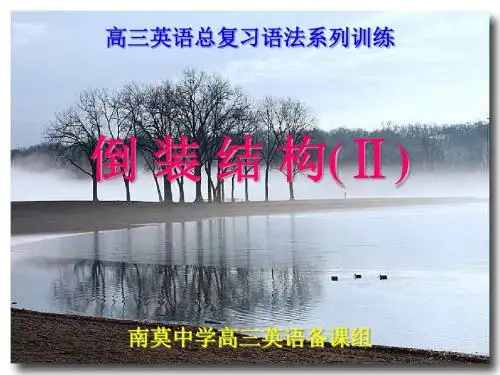
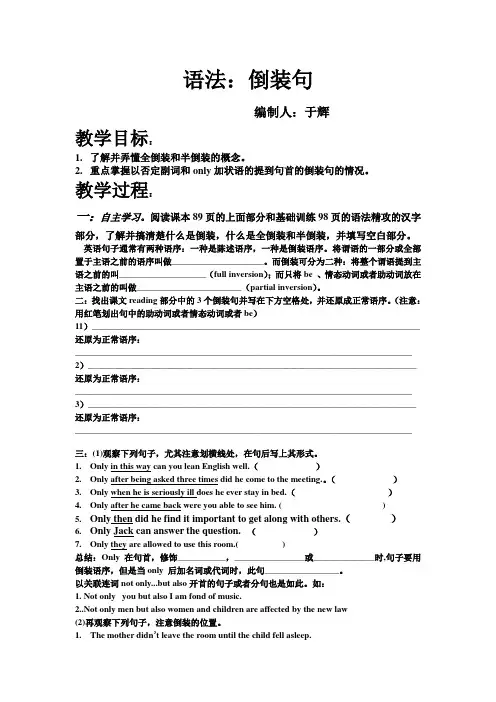
语法:倒装句编制人:于辉教学目标:1.了解并弄懂全倒装和半倒装的概念。
2.重点掌握以否定副词和only加状语的提到句首的倒装句的情况。
教学过程:一:自主学习。
阅读课本89页的上面部分和基础训练98页的语法精攻的汉字部分,了解并搞清楚什么是倒装,什么是全倒装和半倒装,并填写空白部分。
英语句子通常有两种语序:一种是陈述语序,一种是倒装语序。
将谓语的一部分或全部置于主语之前的语序叫做_____________________。
而倒装可分为二种:将整个谓语提到主语之前的叫____________________(full inversion);而只将be 、情态动词或者助动词放在主语之前的叫做________________________(partial inversion)。
二:找出课文reading部分中的3个倒装句并写在下方空格处,并还原成正常语序。
(注意:用红笔划出句中的助动词或者情态动词或者be)11)___________________________________________________________________________ 还原为正常语序:_____________________________________________________________________________ 2)___________________________________________________________________________ 还原为正常语序:_____________________________________________________________________________ 3)___________________________________________________________________________ 还原为正常语序:_____________________________________________________________________________三:(1)观察下列句子,尤其注意划横线处,在句后写上其形式。
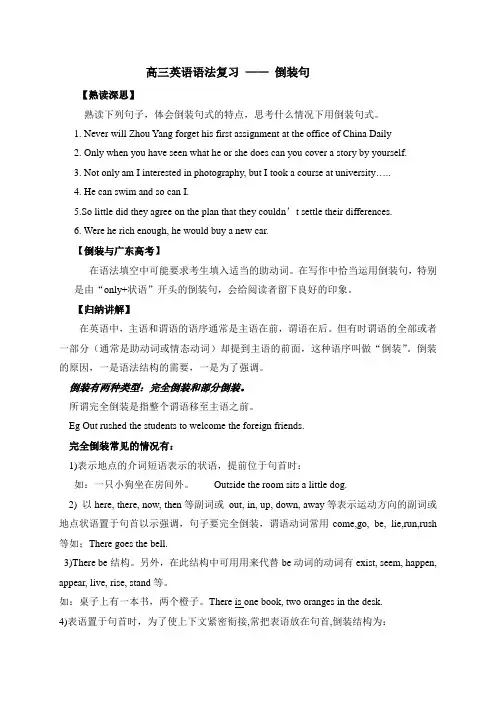
高三英语语法复习——倒装句【熟读深思】熟读下列句子,体会倒装句式的特点,思考什么情况下用倒装句式。
1. Never will Zhou Yang forget his first assignment at the office of China Daily2. Only when you have seen what he or she does can you cover a story by yourself.3. Not only am I interested in photography, but I took a course at university…..4. He can swim and so can I.5.So little did they agree on the plan that they couldn’t settle their differences.6. Were he rich enough, he would buy a new car.【倒装与广东高考】在语法填空中可能要求考生填入适当的助动词。
在写作中恰当运用倒装句,特别是由“only+状语”开头的倒装句,会给阅读者留下良好的印象。
【归纳讲解】在英语中,主语和谓语的语序通常是主语在前,谓语在后。
但有时谓语的全部或者一部分(通常是助动词或情态动词)却提到主语的前面,这种语序叫做“倒装”。
倒装的原因,一是语法结构的需要,一是为了强调。
倒装有两种类型:完全倒装和部分倒装。
所谓完全倒装是指整个谓语移至主语之前。
Eg Out rushed the students to welcome the foreign friends.完全倒装常见的情况有:1)表示地点的介词短语表示的状语,提前位于句首时:如:一只小狗坐在房间外。
Outside the room sits a little dog.2) 以here, there, now, then等副词或out, in, up, down, away等表示运动方向的副词或地点状语置于句首以示强调,句子要完全倒装,谓语动词常用come,go, be, lie,run,rush 等如;There goes the bell.3)There be结构。
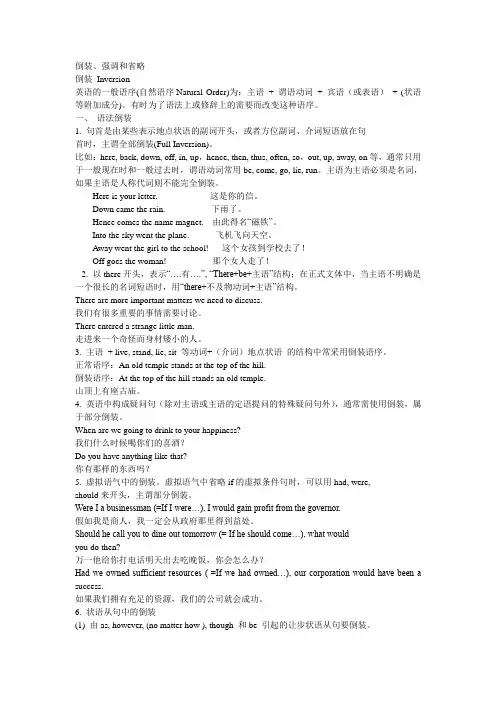
倒装、强调和省略倒装Inversion英语的一般语序(自然语序Natural Order)为:主语+ 谓语动词+ 宾语(或表语)+ (状语等附加成分)。
有时为了语法上或修辞上的需要而改变这种语序。
一、语法倒装1. 句首是由某些表示地点状语的副词开头,或者方位副词、介词短语放在句首时,主谓全部倒装(Full Inversion)。
比如:here, back, down, off, in, up,hence, then, thus, often, so,out, up, away, on等,通常只用于一般现在时和一般过去时,谓语动词常用be, come, go, lie, run。
主语为主语必须是名词,如果主语是人称代词则不能完全倒装。
Here is your letter. 这是你的信。
Down came the rain. 下雨了。
Hence comes the name magnet. 由此得名“磁铁”。
Into the sky went the plane. 飞机飞向天空。
Away went the girl to the school! 这个女孩到学校去了!Off goes the woman! 那个女人走了!2. 以there开头,表示“….有….”, “There+be+主语”结构;在正式文体中,当主语不明确是一个很长的名词短语时,用“there+不及物动词+主语”结构。
There are more important matters we need to discuss.我们有很多重要的事情需要讨论。
There entered a strange little man.走进来一个奇怪而身材矮小的人。
3. 主语+ live, stand, lie, sit 等动词+(介词)地点状语的结构中常采用倒装语序。
正常语序:An old temple stands at the top of the hill.倒装语序:At the top of the hill stands an old temple.山顶上有座古庙。
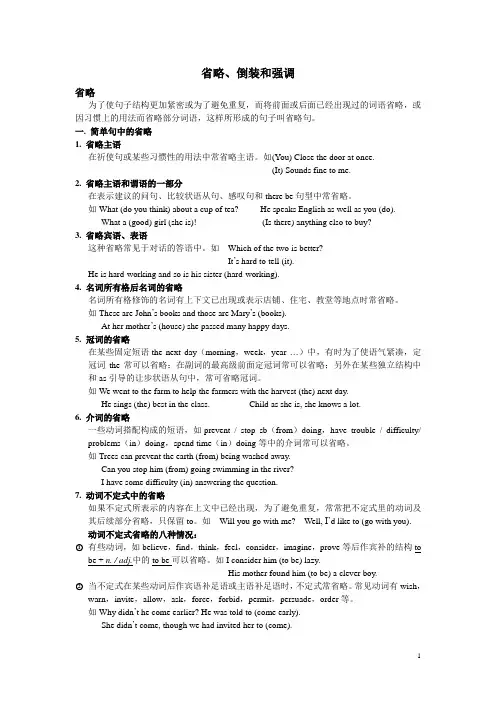
省略、倒装和强调省略为了使句子结构更加紧密或为了避免重复,而将前面或后面已经出现过的词语省略,或因习惯上的用法而省略部分词语,这样所形成的句子叫省略句。
一. 简单句中的省略1. 省略主语在祈使句或某些习惯性的用法中常省略主语。
如(You) Close the door at once.(It) Sounds fine to me.2. 省略主语和谓语的一部分在表示建议的问句、比较状语从句、感叹句和there be句型中常省略。
如What (do you think) about a cup of tea? He speaks English as well as you (do).What a (good) girl (she is)! (Is there) anything elso to buy?3. 省略宾语、表语这种省略常见于对话的答语中。
如---Which of the two is better?---It’s hard to tell (it).He is hard-working and so is his sister (hard-working).4. 名词所有格后名词的省略名词所有格修饰的名词有上下文已出现或表示店铺、住宅、教堂等地点时常省略。
如These are John’s books and those are Mary’s (books).At her mother’s (house) she passed many happy days.5. 冠词的省略在某些固定短语the next day(morning,week,year …)中,有时为了使语气紧凑,定冠词the常可以省略;在副词的最高级前面定冠词常可以省略;另外在某些独立结构中和as引导的让步状语从句中,常可省略冠词。
如We went to the farm to help the farmers with the harvest (the) next day.He sings (the) best in the class. Child as she is, she knows a lot.6. 介词的省略一些动词搭配构成的短语,如prevent / stop sb(from)doing,have trouble / difficulty/ problems(in)doing,spend time(in)doing等中的介词常可以省略。
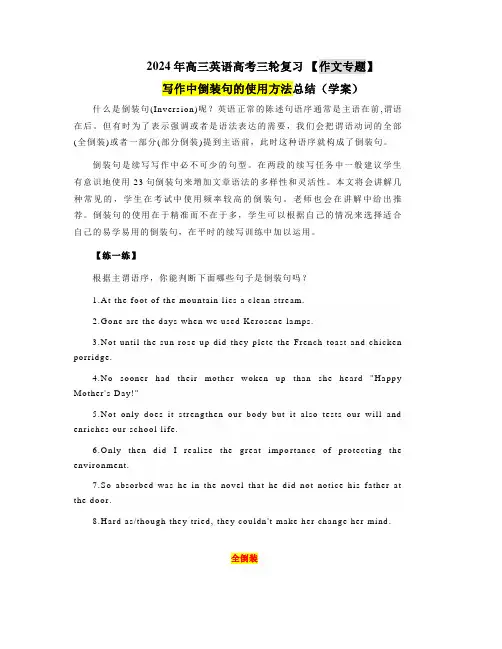
2024年高三英语高考三轮复习【作文专题】写作中倒装句的使用方法总结(学案)什么是倒装句(Inversion)呢?英语正常的陈述句语序通常是主语在前,谓语在后。
但有时为了表示强调或者是语法表达的需要,我们会把谓语动词的全部(全倒装)或者一部分(部分倒装)提到主语前,此时这种语序就构成了倒装句。
倒装句是续写写作中必不可少的句型。
在两段的续写任务中一般建议学生有意识地使用23句倒装句来增加文章语法的多样性和灵活性。
本文将会讲解几种常见的,学生在考试中使用频率较高的倒装句。
老师也会在讲解中给出推荐。
倒装句的使用在于精准而不在于多,学生可以根据自己的情况来选择适合自己的易学易用的倒装句,在平时的续写训练中加以运用。
【练一练】根据主谓语序,你能判断下面哪些句子是倒装句吗?1.At the foot of the mountain lies a clean stream.2.Gone are the days when we used Kerosene lamps.3.Not until the sun rose up did they plete the French toast and chicken porridge.4.No sooner had their mother woken up than she heard "Happy Mother's Day!"5.Not only does it strengthen our body but it also tests our will and enriches our school life.6.Only then did I realize the great impo rtance of protecting the environment.7.So absorbed was he in the novel that he did not notice his father at the door.8.Hard as/though they tried, they couldn't make her change her mind.全倒装全倒装是将谓语动词的全部放在主语之前,即把主语和谓语动词完全颠倒过来。
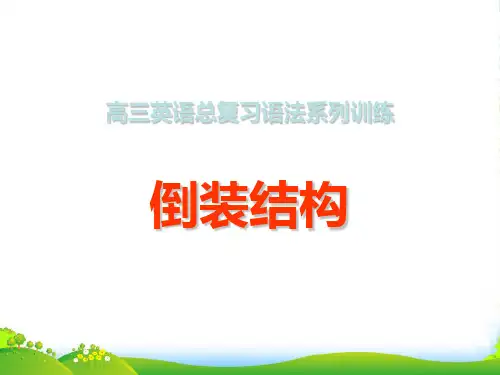
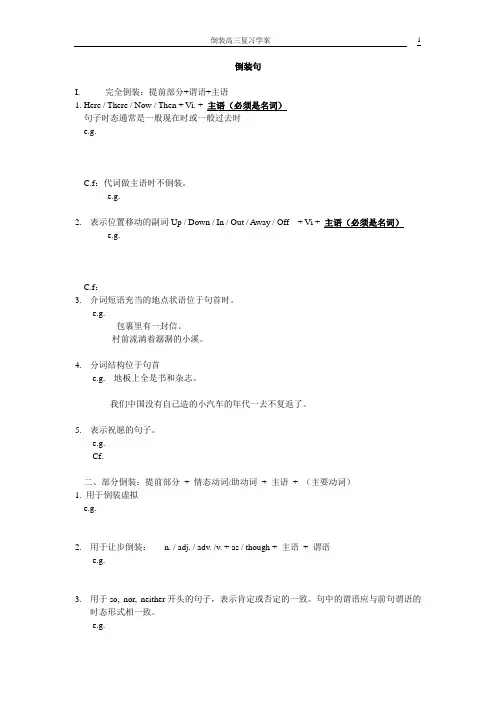
倒装句I.完全倒装:提前部分+谓语+主语1. Here / There / Now / Then + Vi. + 主语(必须是名词)句子时态通常是一般现在时或一般过去时e.g.C.f:代词做主语时不倒装。
e.g.2.表示位置移动的副词Up / Down / In / Out / Away / Off + Vi + 主语(必须是名词)e.g.C.f:3.介词短语充当的地点状语位于句首时。
e.g.包裹里有一封信。
村前流淌着潺潺的小溪。
4.分词结构位于句首e.g. 地板上全是书和杂志。
我们中国没有自己造的小汽车的年代一去不复返了。
5.表示祝愿的句子。
e.g.Cf.二、部分倒装:提前部分+ 情态动词/助动词+ 主语+ (主要动词)1. 用于倒装虚拟e.g.2.用于让步倒装:n. / adj. / adv. /v. + as / though + 主语+ 谓语e.g.3.用于so, nor, neither开头的句子,表示肯定或否定的一致。
句中的谓语应与前句谓语的时态形式相一致。
e.g.Cf: a) 如果前后主语均指同一对象时,表示同意对方意见,或对前面句子内容加以确认时,用正常语序。
e.g. 我朋友答应帮助我做功课,他的确帮我了。
b) 如果前句的谓语动词既有肯定又有否定,或者动词不属于同一类别时,用特殊句型So it is / was with sb. /sth.e.g.4.句首状语为否定词或否定意义的短语时,引起部分倒装。
常见的有:never, seldom, little, few, hardly, scarcely, barely, nowhere, not,by no means(决不), on no account(决不可以,切莫),in no case, under no circumstancese.g. 我以前从没有听过这样一个故事。
我永远不会忘记初上大学的那些日子。
世界上没有其它地方能使我们找到一个如此放松自我的完美地方。
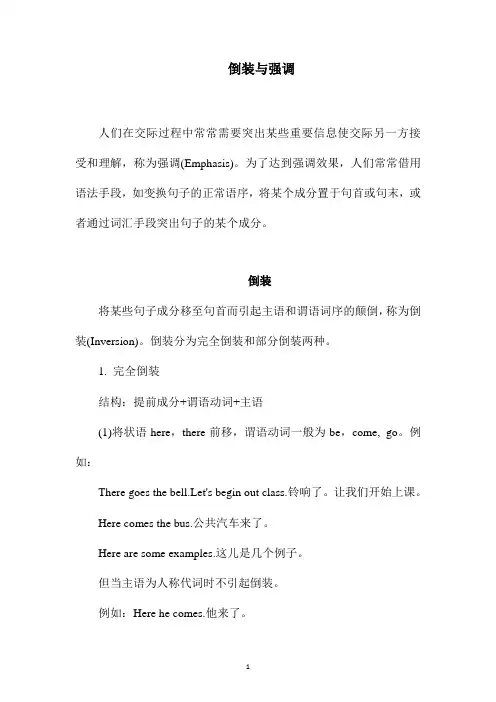
倒装与强调人们在交际过程中常常需要突出某些重要信息使交际另一方接受和理解,称为强调(Emphasis)。
为了达到强调效果,人们常常借用语法手段,如变换句子的正常语序,将某个成分置于句首或句末,或者通过词汇手段突出句子的某个成分。
倒装将某些句子成分移至句首而引起主语和谓语词序的颠倒,称为倒装(Inversion)。
倒装分为完全倒装和部分倒装两种。
1. 完全倒装结构:提前成分+谓语动词+主语(1)将状语here,there前移,谓语动词一般为be,come, go。
例如:There goes the bell.Let's begin out class.铃响了。
让我们开始上课。
Here comes the bus.公共汽车来了。
Here are some examples.这儿是几个例子。
但当主语为人称代词时不引起倒装。
例如:Here he comes.他来了。
Aren't you looking for your bag? Look, here it is.你不是在找包吗?瞧,在这儿。
(2)表示位置转移的副词如up, down,in, out, away, ahead移至句首。
例如:The driver couldn't control his car and down came the car.司机控制不了汽车,汽车向下滑。
Up went the rocket.火箭上升。
Lower flew the eagle till it caught the rabbit.鹰低飞直到抓住兔子。
但当主语为人称代词时不引起倒装。
例如:Away they went.他们走开了。
Higher and higher it flew.它越飞越高。
(3)句首状语为表示地点的介词词组In the centre of the square stands a high monument.广场中央矗立着很高的纪念碑。
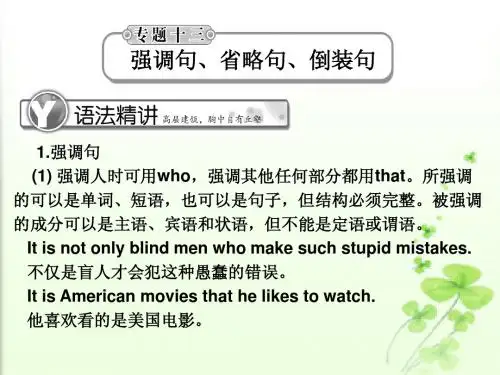
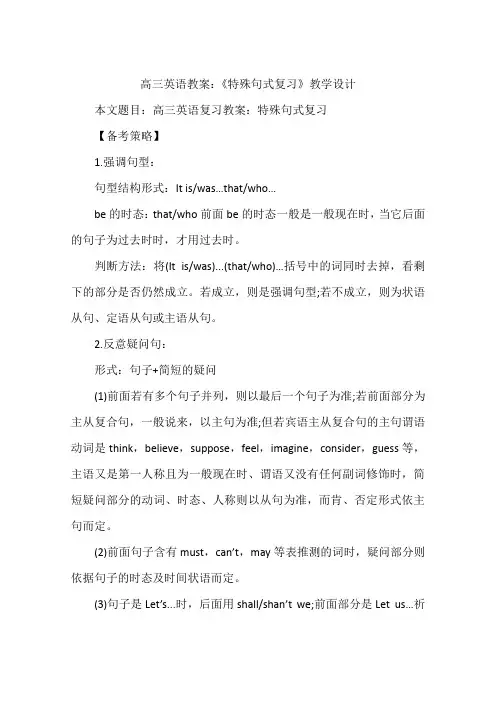
高三英语教案:《特殊句式复习》教学设计本文题目:高三英语复习教案:特殊句式复习【备考策略】1.强调句型:句型结构形式:It is/was…that/who…be的时态:that/who前面be的时态一般是一般现在时,当它后面的句子为过去时时,才用过去时。
判断方法:将(It is/was)...(that/who)…括号中的词同时去掉,看剩下的部分是否仍然成立。
若成立,则是强调句型;若不成立,则为状语从句、定语从句或主语从句。
2.反意疑问句:形式:句子+简短的疑问(1)前面若有多个句子并列,则以最后一个句子为准;若前面部分为主从复合句,一般说来,以主句为准;但若宾语主从复合句的主句谓语动词是think,believe,suppose,feel,imagine,consider,guess等,主语又是第一人称且为一般现在时、谓语又没有任何副词修饰时,简短疑问部分的动词、时态、人称则以从句为准,而肯、否定形式依主句而定。
(2)前面句子含有must,can’t,may等表推测的词时,疑问部分则依据句子的时态及时间状语而定。
(3)句子是Let’s...时,后面用shall/shan’t we;前面部分是Let us…祈使句时,后面用will/won’t you。
(4)前面句子是I’m…时,后面用aren’t l;句子是I’m not…时,后面用am I。
(5)前面是感叹句时,后面跟感叹句的主、谓一致,但用否定形式。
(6)当主语是anyone/anybody/everyone/everybody时,疑问部分用复数形式。
否定、肯定形式:(1)一般说来,前后两部分的否定、肯定形式相反;但当句子前有0h,Ah,so等语气词时,前后两部分的否定、肯定形式相同。
(2)前面部分有否定词或半否定词时,后面部分用肯定形式;但若前面部分含有由否定词缀构成的否定词时,后面部分还是用否定形式。
3.祈使句:祈使句的主语是you,但一般被省略;当前面有呼语时,一般得补出主语you;否定式一般是在前面加Don’t。
1.6一、小测1、如今有些父母后悔没有在孩子小的时候多花些时间陪他们。
2、争辩是什么引起这起事故是没有意义的。
3、笑容如阳光,能驱走人们脸上的冬天。
4、不幸的是他的父亲去世了,使得他的家境更加艰难。
5、他在巴黎出差时顺便学会了一些法语。
6、他对吃的东西特别挑剔,然而不在乎金钱。
7、到2011年,我们城市的人口已经超过两千万。
8、妈妈在书里增加了一些图片信息,使得孩子读起来更容易了。
填入介词9、对。
满意be content _____10、使某人相信某事convince sb ____ sth11、朝。
方向___ the direction12、尤其;特别____ particular13、低声说___ a whisper14、贫穷的be badly _____ 15、认出;挑选pick ___16、捡起;身体好转;偶然习得pick ____17、用。
配备equip sb ____ sth18、集中注意力于focus one’s attention _____19、与。
作斗争struggle ____20、切断;隔绝cut ____二、讲评《5、3》三、主谓一致复习1. The number of people invited ______ fifty, but a number of them _______ absent for different reasons.2、The girl as well as his parents _______ a bike. Not only the students but also the professor ______ surprised at Mary’s answer.3、______ of the land in that district ______ covered with trees and grass.(三分之二)4、Ten minutes ______ a long time for one who waits. (似乎)5、Every possible means _____(已经被试过了),but the problem remained unsolved.6、In those days John with his classmates _____ kept busy preparing for the exam. (be)7、The Smith’s family, which ____ rather a large one, ____ very fond of their old houses.8、What the teacher and the students want to say_____ that either of the countries ____ beautiful. 9、He is the only one of the students who _____ a winner of scholarship for three years.10、The population of the earth _____ increasing fast. One third of the population here _____ workers.11、Politics ___ one of the subjects that I study.12、Here is a message of importance to every man and woman who ___.(vote)13、The number of the people .(拥有车的人数一直在增加)14、What caused the accident and who was responsible for it ___ a mystery to us.(仍然)15、The Olympic Games in the year 2008 ______ in Beijing of China, which ______ known to us all.16、Stories of the Long March_______ popular with the young people now.17、What the children in the mountain village need ________ good books.18、Each student -____ got an English- Chinese dictionary. The students each ______ a dictionary. 19、The policeman ______ standing at the street corner. The police _____ searching for hi20、There ___ priceless jewellery on display at the exhibition hall.21、Some of the oranges ______ turned bad. Some of the milk _______ turned sour (酸).22、My blue trousers ______ worn out. One pair of trousers ______ not enough.23、Our League secretary and monitor ______ the lead in everything. Our League secretary and the monitor ______ good friends. (take; be)24、Every man worker and every woman worker _____ free medical care. At Christmas each boy and each girl _____ given a present. (enjoy; be)25、Going to bed early and getting up early _____ a good habit. Singing and dancing _____ two of the things that he likes best.四、复习倒装完成下列句子1、The door opened and there ____.(那个老人走了进来)2、_____and caught the mouse.(猫跳了起来)3、Never _____such a wonderful place as Hangzhou. (我从没见过)4、Under a big tree ____,half asleep. (坐着一个年轻人)5、She is not fond of cooking,____ I.(我也是)6、I finally got the job I dreamed about. Never in my life ____so happy! (感觉)7、At the foot of the mountain_____.(坐落着一个美丽的村庄)8、Little ___________, though he was in great danger himself.(毫不在乎自己的安全)9、So ______ that no fish can live in it.(湖水这么浅)10、______ for the free tickets, I would not have gone to the films so often. (要不是因为)11、Mr. Smith promised to help me and____ the next day.(的确这么做了)12、直到他下车,他才发现自己的钱包被偷了。
高考英语一轮复习——倒装(附答案)I.考点分析英语句子的一般语序为“主语部分+谓语部分”。
如果在一定条件下,为了达到某些语法或修辞上的效果,改变句子的一般语序,把谓语放在主语的面前,我们称之为倒装(Inverted Order)。
倒装又分为完全倒装(Complete Inversion)和部分倒装(Partial Inversion)。
把谓语部分完全放到主语前称为完全倒装,如Here are some letters for you.把助动词或情态动词放在主语之前,称之为部分倒装,如Never have I heard such nonsense.倒装的考察要点有:1. 以某些副词开头的句子,如:here, now, then, up, down, out, in, 或由副词there, then, now 等引起,谓语动词为come或go,并且主语不是人称代词的句子,应该完全倒装。
例:1) Here comes the bus.2) There goes your last chance.3) Out rushed a tiger from among the bushes.4) Up went the rocket carrying the satellite on its top.2. 有时出于修辞上的考虑可以把表语提前放在主语前面,同时主谓完全倒装。
例:1) Very grateful we are for you help.2) A very reliable person he is, to be sure.3) Very important in the farmers’ life is the weather report.3. 代词neither, nor, no more用于后面分句句首,且前面分句必须是否定句,这时后面分句不仅用倒装结构,而且时态(包括助动词)必须和前句一致。
倒装,强调,省略㈠1.-Susan, go and join your sister cleaning the yard.-Why ______ ? John is sitting there doing nothing.A. himB. heC. ID. me总结:在日常用语中,当人称代词用在不带谓语的句子中作主语时,习惯上用______2.—What do you think made the girl so glad?—_____a beautiful necklace.A.As she received B.Receiving C.Received D.Because of receiving 总结:以上两题只回答了_______,省略了后面的________和________.㈡在限定性定语从句中3. A great number of students____ said they were forced to practice the piano. (10四川)A. to questionB. to be questionedC. questionedD. questioning4. Now that we’ve discussed our problem, are people happy with the decisions_____?A. takingB. takeC. takenD. to take㈢不定式中的省略①5. --Does your brother intends to learn to sing this song?--Yes, he intends ______.A. soB. toC. thatD. it6.—Would you like to have some cakes ?--Thank you._________.A. I’d like toB. I’d like to haveC. I’m fullD. I’d better to home总结:以上题目属于______________的省略,此种类型的省略要保留小品词____.这类动词有:expect,forget,hope,intend,mean,prefer,refuse,try,want,wish,would like 和love等②在have to, need, ought to, be going to, used to等后省略动词,在happy,glad,eager,ready,willing等形容词后面作状语时,可以省略,但要保留不定式符号to。
如:③7. —He hasn’t gone to the office up to now.—Well, he_____.A.should B.ought to C.ought to go D.ought to have总结:当___________中带be, have, have been 等,通常要保留_____ ____ ______④介词but前若有动词do,后面的不定式不带to例The boy did nothing but__play_________. (play)The boy said nothing but __to play______ . (play)⑤某些使役动词(let, make, have)及感官动词(see, watch, hear, notice, observe, feel, look at, listen to等)后面作宾语补足语的不定式一定要省去to, 但在被动语态中须将______复原。
例I saw the boy ___fall______ from the tree. (fall)The boy was seen ___to_fall__ from the tree. (fall)The boss made us _work________12 hours a day. (work)We were made _to_work_______ 12 hours a day. (work)㈣使用替代词的省略1) 通常情况下,在省略了某个词、短语或句子时,还需要用某个替代词。
常用的替代词有:do /does /did, so, not, neither, nor和the same等。
用助动词do /does /did 来替代上下文出现的动词,以免重复。
如:She speaks English more fluently than her elder sister does.2)用so可替代单词、短语或句子(用于肯定) not用于否定,宾语从句可以省略8.--Did Jane pick up some Russian when she was on business abroad?--I imagine _____.A. thatB. she wasC. soD. it9.--- What' s the matter with Della? 09江苏--- Well, her parents wouldn't allow her to go to the party, but she still __A. hopes toB. hopes soC. hopes notD. hopes for总结:在I’m afraid, I think, I believe, I hope, I guess, I expect, I suppo se, I imagine等开头的作答句中肯定回答一律用I’m afraid, think, believe, hope, guess, expect, suppose, imagine _____而否定回答think, 变成I ______think ______或I think ________, 其他的变成I’m afraid/believe/hope/guess/expect/suppose/imagine _______.㈤常见的省略结构10._________it snow tomorrow, we would have to put off the visit to the Yangpu Bridge.A. WereB. ShouldC. WouldD. Will总结:在_____________状语从句中,当助动词是________, ________, _________等时,连词If可省略,但_________, __________, __________需要倒装到主语的前面。
11. Generally speaking, ____according to the direction, the drug has no side effect.A. when takingB. when takenC. when to takeD. when to be taken总结:当状语从句的________与主句的_________一致时,且从句的谓语部分有_____动词的时候,可将从句的_________和________一起省略12. -----Have you got any particular plans for the coming holiday? (08安徽卷)----- Yes, _______, I’m going to visit some homes for the old in the city.A. If everB. If busyC. If anythingD. If possible 总结:当状语从句主语是_____, 其后又有______动词时,可将主语____及_____动词一起省略。
这种结构通常为if it is possible, when it is necessary等。
13.I ______and will never ask such a silly question.A. have neverB. neverC. have askedD. have never asked14.She opened her mouth as if _____something important.A. sayingB. to sayC. having saidD. to have said15.--Who has been planning the summer camp ?--Everyone in the class ________.A.isB. haveC. hasD. are16.—She’s not an English teacher, is she ?-- _________________.A. Yes, and she isn’tB. Yes, but she wasC. No, but she isn’tD. No, but she was17.—Mary is not coming tonight.--But she ______.A. promisesB. promisedC. will promiseD. had promised18-Do you want another drink? (09浙江)-___ _______.A.I don’t think so.B. No wayC. Not at allD. I wouldn’t say no19.If the weather is fine, I’ll wash my clothes. If _____, ______.A. not; notB. no; noC. not; noD. no; not20. _____ twice, the postman refused to deliver our letters unless we chained our dog.09北京A. Being bittenB. BittenC. Having bittenD. To be bittenInversion倒装语序分为“全部倒装”和“部分倒装”。
在全部倒装的句子中,整个谓语都放在主语的前面;在部分倒装的句子中,只是谓语中的一部分(如助动词、情态动词或系动词be等)放在主语前面,其余部分仍放在主语后面。
下面将常见的倒装情况分述如下:一、由there, here 或now 等引起,谓语为come(或go)的句子,二、由then 引起,谓语为come(或follow)的句子三、由here(或there)引导,谓语为be的句子注:如果主语为人称代词,仍用自然语序四、由so引起的,表示前面所说的情况也适用于另一个人(或物)的句子五、由neither或nor引起的,表示前面所说的情况也适用于另一个人(或物)的句子六、在if引导的非真实条件句中,如有助动词had, should或were时,可以省略if,进行倒装七、当as引导让步状语从句时,可以把表语提到前面来,采用“形容词(或副词、名词)+ as +主语+谓语”这种形式八、当always, often, well, many a time等词放在句首时,后面常用倒装语序注:上述所说的词不放在句首,不用倒装语序。